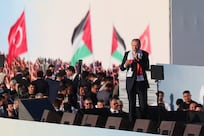Compared to the carnage and human misery caused by the ongoing conflicts in this region, damage to buildings might seem to be just a distraction. But the recent destruction of historic shrines in Mosul and mosques in Gaza, as well as the 900-year-old minaret of the Umayyad Mosque of Aleppo last year, remain worthy of consideration.
It is important to keep this in perspective, because buildings can always be replaced through reconstruction but people cannot. However, there remains an important point to be made about the impact on a community of losing its historic sites. These are not like shopping centres or car parks because they represent what a community considers to be most important, making their destruction akin to a bid to destroy the culture itself.
Take the example of Mosul, where members of the Islamic State group recently blew up shrines to Nabi Shiyt (Prophet Seth) and Nabi Yunus (Prophet Jonah) because they were designated as iconography, which the group condemns as apostasy.
This week Islamic State members came to destroy the Crooked Minaret, a tower dating back to the 12th century and which leans like the Tower of Pisa. The Mosulis protested, forming a human barricade in the mosque's courtyard and the destruction was called off, at least temporarily.
Similarly in Gaza, where some of the most compelling images to emerge include the faithful performing Eid prayers in the remains of a mosque shelled by the Israeli Defense Forces and the partially collapsed minaret of the Al Sousi mosque in Shati refugee camp. Equally telling was the Christian minority in Gaza opening up churches to their Muslim compatriots.
There is nothing new in this process. A similar uproar followed the Taliban’s destruction of the 6th century Buddhas in Afghanistan’s Bamiyan province in 2001, also on religious grounds but condemned around the world because it was also destruction of Afghanistan’s history.
It is important not to focus too much on the physical structure. As the war-devastated German cities of Cologne and Dresden showed, historic buildings can be rebuilt in a way that is almost indistinguishable.
But with the Islamic State’s destruction of Mosul’s shrines, the IDF’s obliteration of dozens of Gaza’s mosques and the Syrian army’s shelling of the minaret in Aleppo, the goal was not so much destroying the structures but the societies they represent.





